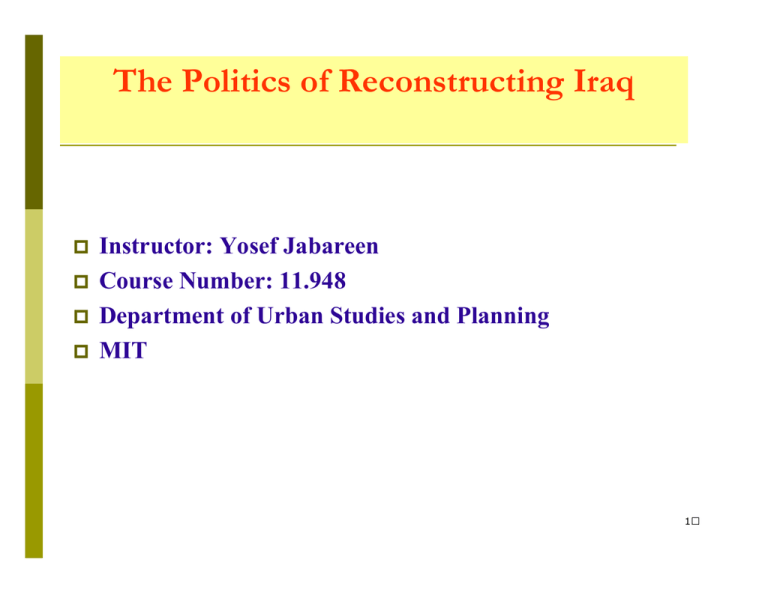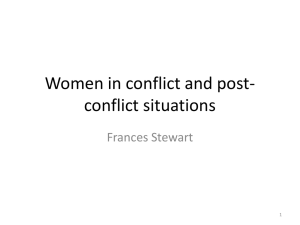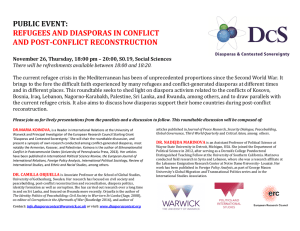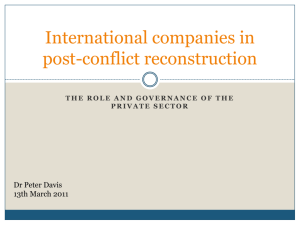The Politics of Reconstructing Iraq Instructor: Yosef Jabareen Course Number: 11.948
advertisement

The Politics of Reconstructing Iraq Instructor: Yosef Jabareen Course Number: 11.948 Department of Urban Studies and Planning MIT 1 Conflict Over 50 countries have experienced significant periods of conflict since 1980. 15 of 20 poorest countries have had a major conflict in the past 15 years. Nearly every low-income country is adjacent to a country that has experienced breakdown and war. 2003 saw a total of 36 armed conflicts in 28 countries. 2 …Conflict In early 2004, war and persecution resulted in: 10 million refugees 25 million internally displaced people worldwide. 3 Categories of Conflict Categories Territorial conflict (Succession conflicts in decolonized territories) Ethnic/sectarian/tribal conflict (Civil wars) Political and Ideological Conflict Intensive external intervention 4 Countries and Conflict Types of Country-Conflict countries that are vulnerable to conflict Levels of poverty countries that are affected by conflict countries in transition from conflict (post-conflict) 5 Features of Post-Conflict Countries Insecurity Uncertainty Violence and repeated cycles of violence Increase in poverty Conflict has impoverished countries and wiped out the achievements of decades of economic development Loss of human life Physical destruction 6 Features of Post-Conflict Countries... Population displacement 30 countries have had more than 10% of their population displaced through conflict In 10 countries the proportion is more than 40% 7 Global Map of Displaced People Turkey GLOBAL MAP OF INTERNALLY DISPLACED PEOPLE, 2004 (230,000-1,000,000) Moldova (1,000) Serbia & Mont. (248,000) Bosnia & Herz. (313,000) Cyprus (210,000) Syria (305,000) Georgia (260,000) Armenia (3,000) Azerbaijan (575,000) Croatia Russian Federation (10,355) (360,000) Iraq (1,000,000) Turkmenistan (undetermined) Uzbekistan (3,400) Macedonia (1,829) Lebanon (50,000-500,000) Israel (150,000-300,000) Palestinian Territories Afghanistan (167,000-200,000) Pakistan (30,000) India (600,000) (21,000-50,000) Mexico (10,000-12,000) Guatemala (242,000) Colombia (1,566,000-3,410,000) Peru Nigeria (200,000) Algeria (1,000,000) Cote D'Ivoire (500,000) Senegal (64,000) Guinea (82,000) Liberia Eritrea Nepal (100,000-150,000) Bangladesh (500,000) Burma (526,000) (59,000) Ethiopia The Philippines (132,000) Somalia (370,000-400,000) Kenya (360,000) Uganda (1,600,000) Burundi (170,000) Rwanda (310,000-450,000) CAR (undetermined) Congo (100,000) (60,000) Angola (40,000-340,000) DRC (undetermined) (2,330,000) Zimbabwe (150,000) (60,000) Indonesia (500,000) Sri Lanka (362,000) Sudan (5,100,000-6,100,000) Note: Data for Colombia has been accumulated since 1985 and for Algeria since 1992. Figure by MIT OCW. 8 Global Map of Conflicts Serbia & Montenegro (Kosova) Bosnia & Herzegovina Turkey Croatia Chechnya Iraq (Kurdistan) Russia Afghanistan (10,355) Tajikistan Pakistan (Sindh) N.Ireland Macedonia Albania Israel Palestinian Territories Guatemala El Salvador Colombia Liberia Nepal Algeria Cote d' Ivoire Sierra Leone Venezuela Sudan Eritrea Ethiopia Nigeria Rep. Congo Angola INCORE: International Conflict Research Korean-Peninsula China (Tibet) Figure by MIT OCW. Uganda Rwanda Burundi Tanzania Taiwan Myanmar (Burma) India (Kashmir) Combodia Sri Lanka Indonesia East Timor 9 Post-Conflict Reconstruction (PCR) Definition of the World Bank PCR “supports the transition from conflict to peace in an affected country through the rebuilding of the socioeconomic framework of the society.”* *(The World Bank, 1998, Post-Conflict Reconstruction: The Role of the World Bank, p. 14) 10 What is Post-Conflict Reconstruction Definition of the World Bank Does not refer only to the reconstruction of physical infrastructure. Does not necessarily signify a rebuilding of the socio-economic framework that existed in a country prior to the onset of conflict. Conflicts, particularly long-lasting conflict, transform societies, and a return to the past may NOT be possible or desirable. Often, the inequities and fragility of the economies and weak governance structures of such societies have played a significant role in creating the conditions for conflict. In such cases, what is needed is a reconstruction of the enabling conditions for a functioning peacetime society in the economy and society and in the framework of governance and rule of law. 11 What is Post-Conflict Reconstruction… Since the early 1990s, the reconstruction of war-torn societies has become a subspecialty within the broader development agenda. Post-conflict reconstruction is a critical step in a continuum between humanitarian relief and longer-term development assistance. “Good development, or development that addresses inequity, exclusion, and indignity, is in itself the best form of conflict prevention.” (Nat Colletta, Manager, Post-Conflict Unit, World Bank) 12 What is Post-Conflict Reconstruction… Post-conflict development is something that defies the exact boundaries of traditional forms of assistance: it is neither sustainable development nor is it humanitarian response.” (Mark Malloch Brown, Vice President, WB) Flexibility. Flexible enough to meet the emergency needs. Yet visionary enough to create the foundation for further development. Beside the immediate relief, reconstruction is supposed to meet and contribute to long run objectives of development 13 Post War Reconstruction vs. PostConflict Reconstruction Post-war reconstruction has focused on rebuilding infrastructure; it is easier to rebuild roads and bridges than it is to reconstruct institutions and strengthen the social fabric of a society. Many difficulties are associated with restoring trust and social cohesion after violent conflict 14 Post-Conflict Reconstruction: The Lack of Theory Fragile political and social conditions endemic to war-torn societies complicate the use of traditional methods of structural adjustment A new field needs redefinition 15 Post-Conflict Reconstruction Post 9/11 Definition Large scales of international intervention in Post-conflict countries in order to change drastically the arenas of the Political, institutional, legal, economic, social, cultural, and spatial settings. 16 The Concepts behind Post-Conflict Reconstruction Post-Conflict Development “Building Peace Through Development” Peace (The World Bank Group) 17 Development, Cycle of Conflict, and Post-Conflict Reconstruction Back on development path Country On development path Post-conflict Country At risk In violent conflict 18 Fields of Intervention in Post-Conflict Countries Social Intervention Political Humanitarian Security Institutional and legal (the role of law) Economic Civil Society Human rights Cultural “Women” (Gender issues) 19 Scales of Political and Institutional Interventions Different scales in terms of Political and Institutional interventions Minor Bosnia Kosovo Intensive Extreme Grand Intervention Scales of Intervention Somalia Haiti, Sudan DarFur Intervention Iraq Afghanistan 20 Between April and June 1994, 800, 000 people were killed in a programmed genocide GDP fell by 50 percent Stability was restored after a new government took over in July 1994 On the economic front, the country registered a very high level of growth in the immediate aftermath of the conflict, before stabilizing it at a steady 6 to 7 percent a year. It took until 2002 to reach again the GDP of 1992 – and it may take until 2020 to reach the level of income per capita it had in 1990. Low ion vent Inter Sc In ales t er o ve f nt ion Scales of Interventions: The Case of Rwanda 21 Rwanda Between April and June 1994, 800 000 people were killed in a programmed genocide GDP fell by 50 percent Stability was restored after a new government took over in July 1994 On the economic front, the country registered a very high level of growth in the immediate aftermath of the conflict, before stabilizing it at a steady 6 to 7 percent a year. It took until 2002 to reach again the GDP of 1992 – and it may take until 2020 to reach the level of income per capita it had in 1990. 22 Agenda of Post-Conflict Reconstruction Managing conflicts Promoting reconciliation and peace “Agenda for Peace”* Quickly became a milestone for peace after the end of the Cold War Preventing conflict reoccurrence Avoiding future conflicts * (Boutros Boutros Ghali, the Secretary General; January, 31 1992) 23 The Concepts Post-Conflict Reconstruction: Critiques Western Concepts of Justice, Statehood, and Culture American Hegemony Neocolonialist Control and a New-Order Modernist Concept In fact, post-conflict countries still experience high levels of social, ethnic, and religious conflicts, violence, human rights abuse and a large scale of population displacement “In-Conflict countries”? 24




